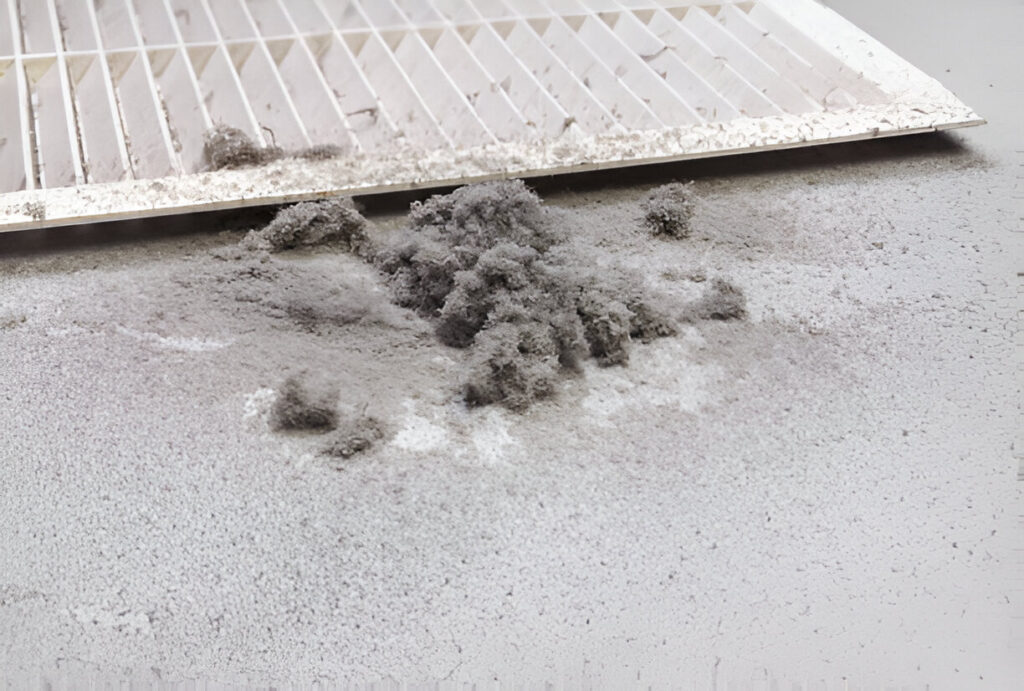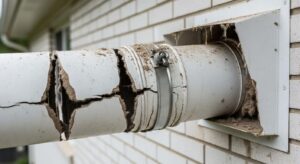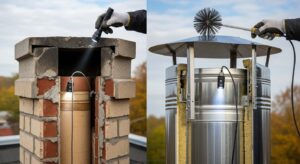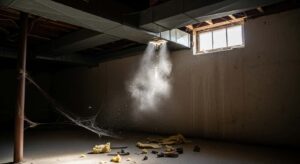Is your home plagued by dust, allergens, or poor air flow? Selecting the right air duct cleaning method can be complicated, especially in 2025, when the choices are endless. You might be asking yourself what really works and just what is considered a waste of money.
Don’t worry, because this article will clarify everything for you. We will keep it simple. We will show you the best way of cleaning your air ducts, and give you answers you can be sure of, regardless of whether you’re a first-time cleaner or simply want a better clean this time around.
Read this blog to learn more about air duct cleaning.
Understanding Air Duct Cleaning
Before getting straight to the best method, it’s essential to first understand what air duct cleaning is and why it is so important.
Well, your home’s duct system is kind of like a pair of lungs: it moves heated or cooled air through vents into every room of your house. And over time, dust, pollen, pet hair, mold spores, and yes, even dead bugs can accumulate inside your ducts. When those particles are trapped in your ducts, they won’t flow out of your vents when the system is working; instead, they will blow into your living space, affecting the air you and your family breathe every day.
So why is it important?
Here are some potential consequences of dirty air ducts:
- Allergy and asthma symptoms caused by airborne irritants
- Odor problems: a musty smell that just won’t go away
- Air flow problems: hotter in one room and cooler in another
- Higher utility bills, because the HVAC unit has to work harder to push past a partially clogged duct system
- Dust piling up on your furniture, even after using a duster constantly
So, scheduling regular air duct cleaning not only improves your indoor air quality, but it also protects and saves your HVAC system, saves your energy, and helps make your home a healthier place to live.
Now, let’s learn the most effective air duct cleaning method.
What’s the Most Effective Air Duct Cleaning Method in 2025?
When done right, source removal remains the industry-leading, most effective air duct cleaning method, even in 2025.
What Is Source Removal?
Source removal is a professional-only technique that uses mechanical agitation (rotating brushes or air whips) and HEPA-filtered vacuum systems that operate continuously under negative pressure.
The source removal’s objective is to displace dust, dirt, and other contaminants out of the ductwork and completely remove them using the vacuum system, and to prevent the debris from escaping back into the living space during the cleaning.
Why It Stands Out
Comprehensive Cleaning
Source removal removes particles at their source, allowing us to clean not just the duct surfaces but also the duct internals to the NADCA ACR Standard when compared to most spray-only/general cleaning methods, which can just clean the surface.
Healthier Indoor Air
A study of cleaning methods showed that although all cleaning methods agitate particles, the air sweep with HEPA extraction gave the most reduction in airborne bioaerosols in the house. Post-cleaning demonstrates a cleaner indoor air environment over time.
Industry & Regulatory Backing
For many years, both NADCA and the EPA have recommended source removal as a best practice. ACR standards, now globally recognized, emphasize their effectiveness and compliance with 2025 indoor air quality regulations.
Proper Debris Capture
HEPA vacuums create negative pressure, which is an important component to cleaning the ductwork and removing any form of material that is dislodging inside, to not allow this form of material to return to the duct or indoor air stream.
Caution About Other Methods
- Chemical sprays or sanitizers: Although they may briefly eliminate surface contaminants or odor, they will not get rid of settled debris. With mold, they will often either be overdone or overpriced, and they may do more harm than good without remediation.
- High-pressure air whipping only: Without negative pressure extraction, this technique can only agitate particulate matter without capturing it, which will worsen your indoor air quality.
- Robotic tools or UV-C sanitization: These are new emerging technologies that can be useful as an adjunct to source removal, but not primarily as cleaning methods. The UV light only kills pathogens. It does not remove dust or debris.
What Proper Source Removal Includes?
A thorough air duct cleaning service using source removal should include:
| Component | Description |
| Inspection | Visual and/or camera inspection of ductwork and HVAC components |
| Mechanical agitation | Roto brushes or air whips to loosen particles |
| HEPA vacuum extraction | Truck-mounted or portable vacuum creating sealed negative pressure zones |
| Debris containment | Bagging debris for safe removal; preventing cross-contamination |
| Optional sanitization | UV‑C or EPA‑approved sprays only after debris removal, not instead of it |
| Post-check | Final camera inspection to confirm cleanliness and airflow improvements |
These steps align with NADCA’s ACR Standard and represent the gold standard in 2025 professional duct-cleaning practice.
Some Other Effective Air Duct Cleaning Methods
While source removal is still the gold standard, the following alternatives can also be effective, particularly when performed by certified professionals with the right equipment.
Rotary Brush Cleaning
Rotary brush cleaning utilizes rotating brushes whirling inside a duct, which allows the brushes to scour the duct wall surfaces and to release the dust and debris to be vacuumed out. It is particularly effective within the rigid or metal round or oval ductwork, yet is not without caution.
Rotary brushes may damage flexible ducts or older style systems if performed inappropriately. There is consensus across several resources: brushes work on the metal systems, and they should not be used on the softer style duct systems.
Air Sweep (Push–Pull) Cleaning
This method employs compressed air whips, or skipper balls, to agitate dust, while a negative-pressure HEPA vacuum sweeps the dust particulates up. The “push” creates the agitation, and the “pull” will capture it with the vacuum pressure system.
Research studies indicate air sweep cleaning substantially reduces bioaerosol levels after cleaning, which can support long-term indoor air quality, an important consideration when contamination is not visually apparent.
Why This Still Falls Short of Source Removal
- Rotary brushing is often offered as a standalone service, without the accompanying deep system vacuuming, particularly in main duct trunks or more intricate configurations, and it may leave behind residual debris.
- Air sweep, without appropriate and continuous negative pressure, cannot be said to do anything other than dislodge dust, as it fails to contain and extract completely. If the air sweep is used incorrectly, it can (and probably will) deteriorate or worsen your contamination.
When done correctly, and with a complementary approach to negative pressure vacuuming and mechanical agitation, both methods thoroughly support source removal. However, neither approach will offer complete source removal as defined and guided by NADCA’s ACR standards for permanent, safety-oriented cleanliness of air duct systems.
Alpha Clean Air: Your Trusted Air Duct Cleaning Service
Why use Alpha Clean Air for your air duct cleaning needs? Because, in NJ, NY, CT, and PA, Alpha Clean Air is the trusted name in air duct cleaning! With over 10 years and 5,000+ projects under their belts, we combine both EPA and NADCA certified training with reliable and effective methods.
We use ACR-compliant procedures for their air duct cleaning process, including carbon monoxide testing, agitation using strong brushes and air whip techniques, HEPA vacuum extraction, and eco-friendly sanitization with tea tree oil. This not only gets your air ducts clean but also helps achieve cleaner air in the home or workplace, helps HVACs perform better, and reduces possible allergens.
Any customer can expect same-day service, no hidden fees, and a 100% satisfaction guarantee. Our technicians are all trained to the highest standards, use only approved disinfectants, and respect your home or office throughout the cleaning process.
No matter if it’s a small apartment or a large commercial structure, you will experience professional, reliable, and environmentally sensitive service from Alpha Clean Air every time.
For more information or to set up service, visit alphacleanair.com
Also Read: Will Air Duct Cleaning Reduce Dust
Final Words
Keeping your air ducts clean in 2025 is more important than ever because you will breathe cleaner air, save on energy bills, and more effectively make your living space comfortable. The best and most trusted method today is source removal. It is safe, deep, and accepted by leading professionals in the industry.
If you need that source removal you can trust, Alpha Clean Air provides expert air duct cleaning that operates under strict NADCA and EPA protocols. We have the right tools and processes to ensure your ducts are cleaned effectively.
Don’t wait for dust or allergies to become a problem. Take action and enjoy a healthier indoor environment starting today.
FAQs
When is air duct cleaning necessary?
Air duct cleaning is usually needed every 3–5 years. But if you see mold, smell musty odors, notice pests, or experience allergy flare-ups, you should get your ducts inspected and cleaned sooner.
Is air duct cleaning worth it?
Yes, when done at the right time. It improves air quality, reduces dust and allergens, and can boost HVAC performance. However, it’s not something you need to do every year, only when signs call for it.
Are air duct cleaning chemicals safe?
Only EPA-approved chemicals should be used, and only after a proper mechanical cleaning. When applied correctly by professionals, they’re safe. Avoid services that rely only on spraying without cleaning.
Will air duct cleaning remove the smoke smell?
Duct cleaning can reduce smoke odors, especially if the smell is trapped in dust or residue. But to remove it completely, the source, like nicotine stains, must also be addressed.
Will air duct cleaning get rid of mice?
Cleaning removes droppings and nesting debris, but won’t get rid of live mice. You’ll need pest control first. After that, cleaning helps sanitize the system and prevent health risks.





